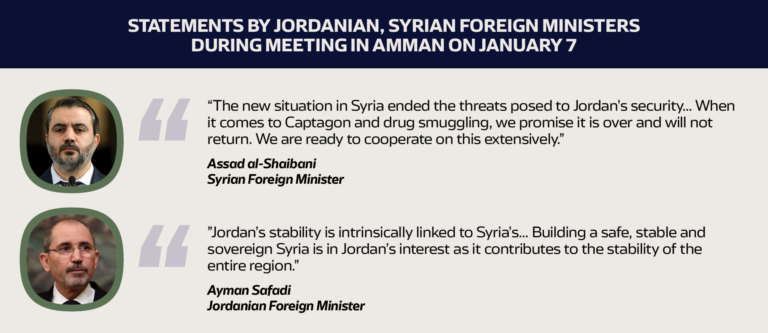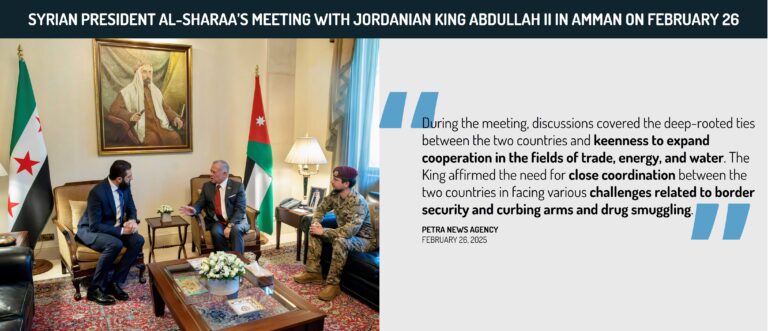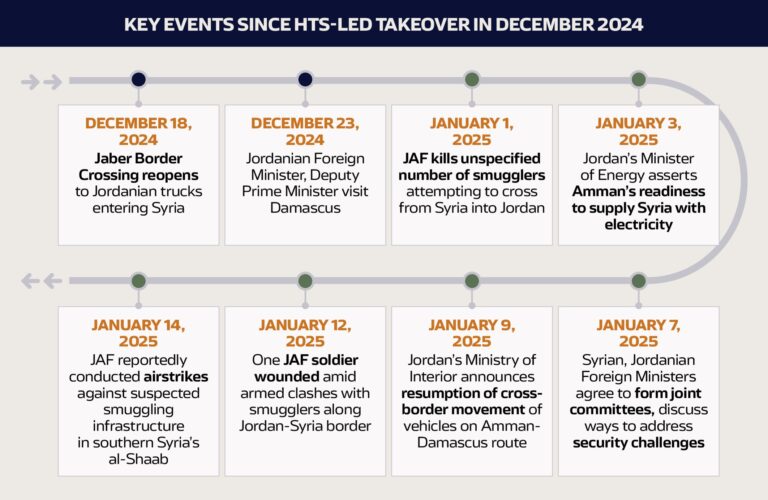
MAX Intelligence: HTS in Syria – Strategic Risks & Iranian Threats Facing Jordan
- MAX Security
Table of Contents

Rising threats from Iran and cross-border instability challenge Amman’s security and regional alliances.
Highlights
-
The HTS-led takeover in Syria has not posed a direct or significant threat to Jordan’s domestic stability at the current juncture. This is partly owing to HTS’ resolve to establish its authority internally and prevent a spillover to neighboring countries. Nevertheless, Amman will view the new developments in Syria as a strategic risk.
-
Given Iran’s reduced influence in Syria since the fall of its ally al-Assad, Tehran will aim to increase arms smuggling to its proxies via Jordan, given the latter’s strategic positioning and pro-Palestinian demographic.
-
Iran will also seek to increase its operational footprint in Jordan and destabilize it as part of a strategic goal to make it an additional front against Israel and to undermine a key US ally in the region, particularly in light of heightened tensions between Tehran and Jerusalem/Washington.
-
These strategic challenges will drive Amman to increase engagement with the Syrian transitional government, leveraging its support on HTS acquiescence to combatting security issues along the Jordan-Syria border.
-
Jordan will also seek to bolster its cooperation with the US, Israel, and the Saudi-led bloc to secure its borders and prevent Iranian destabilization activities within Jordanian territory.
Background:
Jordan shares an approximately 375km border along its northern front with Syria, rendering it susceptible to spillover risks from Syrian territory. Under the former President Bashar al-Assad-led government, these included: cross-border smuggling of weapons and drugs that periodically resulted in lethal clashes with the Jordanian Armed Forces (JAF); an influx of Syrian refugees fleeing the civil war which further strained Amman’s economy; and Iran-backed militia activity in Syria which translated into a strategic threat and also resulted in a rare attack on US forces stationed at Tower Base 22 in January 2024. The Hay’at Tahrir al-Sham (HTS)-led takeover in Syria in December 2024 ended more than 50 years of rule of the al-Assad family in Syria. This will likely raise new concerns for Jordan regarding the spillover impact to stability and security in the Hashemite Kingdom. This report will discuss some of these new strategic challenges impacting Jordan and Amman’s stance on them.
Overview:
Amman will continue to perceive HTS-led takeover as strategic threat despite absence of direct impact on Jordan so far
-
Amman likely perceived the historic overthrow of former President Bashar al-Assad as a direct threat to Jordanian security, which it views as intrinsically linked to Syrian stability. In the initial stages, this likely derived from concerns that the HTS-led forces, or more radical factions within its umbrella movement, would seek to further expand their rapid and historic territorial gains in Syria by immediately influencing and supporting hardline Islamist movements in Jordan and thus destabilizing the Jordanian monarchy. This is because such movements with jihadist inclinations support the ousting of regional monarchies and emirates for the sake of establishing Islamic caliphates. Another concern was the possibility of jihadist factions in Syrian posturing on the Jordanian border in a direct kinetic threat against Jordan, or a spillover of violence onto Jordanian soil. However, this did not materialize, partly owing to Amman’s vigilance along its northern frontier and the HTS-led authorities’ efforts to project good governance practices to acquire regional and international support rather than seeking to expand its territorial control or destabilize neighboring states. This is supported by HTS leader and Syrian President Ahmed al-Sharaa’s early assertion in December 2024 that the new authorities would not allow Syria to become a launchpad to “attack or destabilize any Arab or Gulf country.”
-
That being said, concerns likely persist among the Jordanian monarchy regarding the potentially radicalizing impact that the Islamist HTS’ unprecedented success could have on fringe Salafist-Jihadist elements present in Jordan. The monarchy will also retain concerns that HTS-led authorities could provide material support to such actors in Jordan in the long term to engage in destabilizing activity within the Hashemite Kingdom. It currently remains unlikely that extremist elements in Jordan retain sufficient organizational or operational capabilities to challenge Jordan’s highly effective security apparatus at this stage. This is supported by an apparent absence of increased militancy or unrest among such actors in Jordan since December 2024. Additionally, HTS is unlikely to sponsor destabilizing activity beyond its borders currently while it grapples with more strategic domestic issues such as socioeconomic recovery and sanctions relief, as well as challenges in consolidating its authority domestically in Syria.
-
While HTS is unlikely to directly intervene in Jordan, Amman will be cautious regarding the impact of the HTS-led takeover on the political sphere. This is particularly in light of the considerable gains made by the Muslim Brotherhood-associated Islamic Action Front’s (IAF) that emerged as the largest party in the September 2024 parliamentary elections. Authorities may retain reservations that the IAF could be emboldened to further criticize the Western-aligned monarchy which it has previously denounced for continued ties with Israel and the US. In this context, Jordan’s security establishment will likely increase its vigilance and monitoring of the population to mitigate the threat of developments in Syria becoming a source of inspiration for the aforementioned domestic factions. This is to ensure that they do not pose a significant threat to Jordanian King Abdullah II.
HTS takeover in Syria to prompt increased Iranian efforts to strengthen operational foothold in Jordan
-
The HTS-led takeover in Syria could still indirectly undermine Jordan’s security environment. Former Syrian President al-Assad maintained close ties with Iran, permitting Syria to become an arena for Iran’s regional “ring of fire” against Israel. This included the development of military supply routes and weapons storage across Syria to assist Iran in arming its regional proxies, including Hezbollah in Lebanon and Palestinian militant groups in the West Bank. However, the recent HTS takeover in Syria has significantly disrupted this supply chain, as indicated by Hezbollah Secretary General Naim Qassem’s assertion in December 2024 that the group’s military supply routes through Syria were severed following the HTS takeover.
-
In light of this, Iran will seek alternatives to rearm Hezbollah and continue supplying arms to Palestinian factions in the West Bank. This will include renewed efforts to establish connections with armed criminal syndicates along the Jordan-Syria border who engage in frequent drugs and arms smuggling attempts along the frontier for financial gains. This has already resulted in several instances of clashes even after the HTS-led takeover (see below). In this respect, Tehran is unlikely to completely forsake its desire to establish smuggling routes through Syria.
-
However, Iran will also attempt to establish new routes, with Jordan likely constituting a key focal point given its strategic positioning through shared borders with Israel, the West Bank, Syria, Iraq, and Saudi Arabia. In addition to its strategic positioning, Jordan’s population likely constitutes a viable recruitment pool for Iranian activity, either in exchange for remuneration amid the poor socioeconomic climate or among those ideologically aligned with Iran’s hostile stance against Israel and the US. Many such individuals likely reside in Jordan, where broad segments of the populace are of Palestinian descent and harbor extensive anti-Israel and, by extension, anti-government sentiments over Amman’s ties with Jerusalem.
-
These factors have likely contributed to the success of previous Iranian smuggling efforts to Tehran’s regional proxies via Jordan in the past. This is demonstrated by the discovery of alleged Iranian explosives in Amman in June 2024, and arms seizures in Israel and the West Bank emanating from the porous Israel-Jordan border. This points to the existence of extensive illicit networks in Jordan that Iran would try to bolster and utilize to increase its arms transfers through the country.
-
More broadly, Iran may also seek to directly increase its operational footprint in Jordan in light of its significantly diminished foothold in Syria. This would serve two primary purposes. Firstly, in terms of arms smuggling, it would align with Iran’s efforts to open an additional front against Israel in the West Bank via Jordan as part of its “ring of fire” approach. The primary goal here would be to solidify smuggling routes through Jordan and master the infiltration of status quo-breaking arms (like RPGs and military-grade explosives) into the West Bank. This, in turn, would become a more robust threat against Israel at a time when Iran’s primary ally, Hamas in Gaza, was significantly degraded.
-
Secondly, as part of a more long-term strategic objective, Tehran would seek to undermine the Jordanian monarchy and turn the Hashemite Kingdom itself into a front in the “ring of fire” vision. The intention of Iran and its allies in this regard was already underscored before the fall of al-Assad. It was highlighted by the assertion of prominent Iranian proxy Kataib Hezbollah that it was ready to arm 12,000 fighters in the “Islamic Resistance in Jordan” to cut off roads connecting Israel and Jordan in April 2024. This underscores the strategic goal of Iran and its proxies to increase Israel’s isolation by increasing their influence in Jordan. This is a stance that directly challenges the Jordanian monarch, which is also part of Iran’s desire to destabilize the prominent US ally that aligns with Washington’s operations in the region. This was demonstrated by Jordan’s participation in the US-led defensive alliance that helped thwart Iran’s aerial attacks on Israel in April and October 2024.
-
In this context, Iran has apparently already undertaken efforts to destabilize Jordan by promoting sabotage acts in the Hashemite Kingdom. This is exemplified by the detention of a Hamas-linked Muslim Brotherhood cell comprising Jordanian nationals of Palestinian descent who intended to conduct sabotage acts with Iranian arms in March 2024. This again underscores susceptibility among segments of Jordan’s predominant Palestinian demographic that can be exploited by Iran to directly undermine Jordanian security. Iran’s desire to advance these objectives will be augmented by the succession of US President Donald Trump who has continued his hardline stance against Iran through the reinstallation of the “maximum pressure” sanctions campaign, and amid Iranian concerns that Washington would support an Israeli operation to target its nuclear facilities.
Outlook:
-
While the Jordanian monarchy will approach with caution, it is likely to embrace the new Syrian government. The aforementioned strategic challenges are likely to influence Jordan’s foreign policy and drive Amman to engage with the new HTS-led authorities given that Syria’s stability is a strategic security concern for Jordan. In this context, Amman will seek to increase its coordination with the Syrian transitional government. This is supported by the formation of joint Jordanian-Syrian committees on January 7 and pledges from officials to increase security cooperation, which will likely particularly focus on the border region. Amman will likely aim to leverage its superior military capabilities in a quid pro quo approach to acquire intelligence from HTS-led authorities of smuggling networks in southern Syria that pose a threat to Jordanian territory. Such coordination may have facilitated reported JAF airstrikes against smuggling infrastructure in Syria’s al-Shaab on January 14.
-
More broadly, Jordan may aspire to reduce the spillover risks and strengthen Syrian stability by strengthening diplomatic and economic ties with the HTS-led authorities in a carrot and stick approach. Jordan previously attempted to deploy this tactic by stipulating Syria’s reintegration to the Arab League in 2023 upon commitments by the former al-Assad government to crack down on suspected state-sponsored Captagon production and smuggling through Jordan and the broader region. With regard to the nascent HTS-led government, Amman may offer material or diplomatic support as the Syrian transitional government aims to catalyze economic recovery and legitimize its authority in exchange for an HTS-led crackdown on Captagon-related activities. In the near term, this could include the provision of energy or goods, as indicated by the Jordanian Minister of Energy and Mineral Resources assertion that Amman is ready to supply Syria with electricity and natural gas on January 3, and during a meeting between King Abdullah II and President Ahmad al-Sharaa on February 26. The broader stabilization and economic recovery in Syria could also benefit Jordan by increasing the willingness of approximately 1.3 million Syrian refugees residing in Jordan to return to Syria, thereby reducing strain on Jordan’s economy.
-
With regard to Iran’s anticipated efforts to increase smuggling and destabilizing activity in Jordan, Amman may increase its coordination with Jerusalem. A particular focus will remain the porous Israel-Jordan border, which Jerusalem and Amman will seek to strengthen through increased patrolling and potentially the construction of a long-proposed fortified border fence.
-
Iranian efforts to foment destabilizing activity within Jordan itself, to compensate for Tehran’s reduced influence in Syria, will likely lead Amman to bolster its cooperation with its traditional allies, the Saudi-led Gulf bloc, as well as Washington, in particular. This will likely include increased US military support and coordination, including funding, training of JAF personnel and the deployment of US troops in Jordan which has reportedly already increased to over 3,000 soldiers since the Israel-Hamas war began. While this may be complicated in the short term by President Trump’s recent demands for Jordan to take in Palestinian civilians from Gaza which Jordan has firmly rebuffed, both parties will seek to strengthen their strategically important ties. Amman will also further align with its traditional Gulf allies, mainly Saudi Arabia and the UAE, who are also engaged in consorted efforts to increase their influence in Syria and the region and mitigate the threat posed by Islamist/jihadist forces.
SCOUT
INTEL AI BY MAX SECURITY
Fill in your details to schedule a demo with our team.






